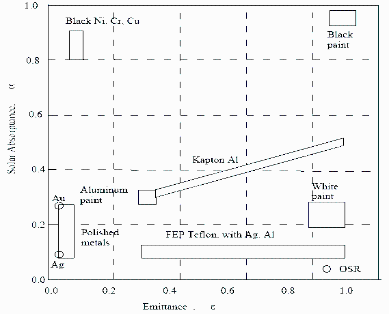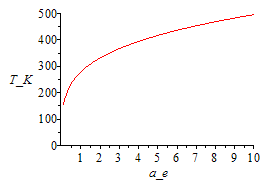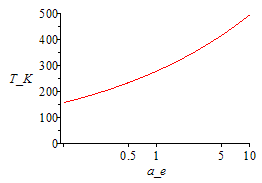| > | restart:#"m13_p36" |
Find the steady temperature for an isothermal sphere at geosynchronous orbit, neglecting Earth interactions, as a function of surface absorptance divided by surface emissivity, with application to a blackbody (’üĪ’Ć»’üź=1/1), a white painting with ’üĪ’Ć»’üź=0.20/0.85, a black painting with ’üĪ’Ć»’üź=0.95/0.90, an aluminised painting with ’üĪ’Ć»’üź=0.30/0.30, a golden painting with ’üĪ’Ć»’üź=0.25/0.03, and a second surface mirror with ’üĪ’Ć»’üź=0.08/0.80.
Data:
| > | read`../therm_eq.m`:read`../therm_const.m`:read`../therm_proc.m`:with(therm_proc):with(plots): |
| > | dat:=[E=1370*W_/m_^2,Re=6378e3*m];Surf:=[blackbody,white_paint,black_paint,aluminised_paint,golden_paint,SSM];a_e_:=[1/1,0.20/0.85,0.95/0.90,0.30/0.30,0.25/0.03,0.08/0.80]; |

Fig. 1 Types of radiative surfaces according to thermo-optical properties.
Eqs. const.:
| > | dat:=op(dat),Const,SI2,SI1: |
a)Find the steady temperature for an isothermal sphere at geosynchronous orbit, neglecting Earth interactions, as a function of surface absorptance divided by surface emissivity
Extraterrestrial solar irradiance E=1370 W/m2 is practically the same at GEO or LEO (40 000 km can be neglected against 150 million km).
| > | eqEB:=alpha*Pi*R^2*E=epsilon*4*Pi*R^2*sigma*Tst^4;Tst:=(alpha*E/(4*epsilon*sigma))^(1/4);a_e:alpha/epsilon;Tst:=(a_e*E/(4*sigma))^(1/4);plot(subs(dat,SI0,Tst),a_e=1e-1..1e1,T_K=0..500);semilogplot(subs(dat,SI0,Tst),a_e=1e-1..1e1,T_K=0..500); |
 |
 |
b) Application to a blackbody (’üĪ’Ć»’üź=1/1), a white painting with ’üĪ’Ć»’üź=0.20/0.85, a black painting with ’üĪ’Ć»’üź=0.95/0.90, an aluminised painting with ’üĪ’Ć»’üź=0.30/0.30, a golden painting with ’üĪ’Ć»’üź=0.25/0.03, and a second surface mirror with ’üĪ’Ć»’üź=0.08/0.80.
| > | for i from 1 to nops(Surf) do Ti:=evalf(subs(a_e=a_e_[i],dat,SI0,Tst));print(Surf[i],`alpha/epsilon=`,a_e_[i],Ti*K_,TKC(Ti*K_));od: |
Notice how hot the golden paint becomes, and how cold the SSM; second surface mirrors (SSM), also known as optical solar reflectors (OSR), particularly when quartz is used, are transparent thin materials, 0.25 mm thin quartz plates or Teflon films, metallised on the back (silver or aluminium), where they are bonded to a substrate support, widely used for radiators.
| > |